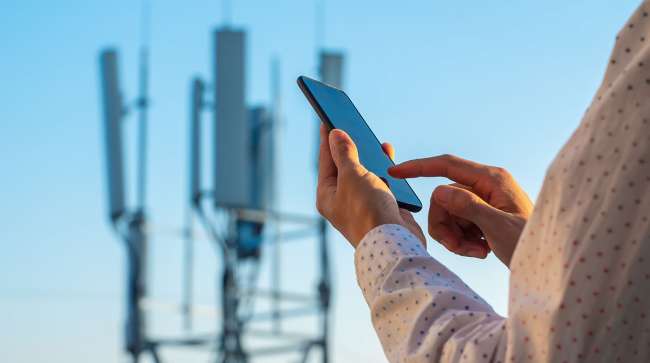Senior Reporter
3G Cellular Network Sunsetting Raises Concerns in Trucking

[Stay on top of transportation news: Get TTNews in your inbox.]
While the timing is expected to vary, many wireless cellular providers plan to phase out or “sunset” their remaining 2G and existing 3G networks early next year, according to the Federal Communications Commission.
Because of that upcoming move, telecommunications experts told Transport Topics trucking fleet owners and operators need to begin planning to replace or upgrade many of their communications and analytic devices, including electronic logging devices. Failing that, they run the risk of their equipment not working or being incompatible with the faster 4G and 5G networks that will replace the older 3G systems.
When the transition is finished, ELDs and other devices that run on 3G no longer will be able to transmit data to the fleet owner’s back office or to law enforcement agencies and will be obsolete. The Federal Motor Carrier Safety Administration already has established what it is calling a “revoked ELD list” of devices that won’t work in a matter of months.
Do you have a 3G phone? If you answered yes to that question, then you should prepare for when mobile service providers begin phasing out their 3G cellular networks and service. Plan ahead for the 3G sunset. Details here: https://t.co/QTgy1zt8fv #FCCGov — The FCC (@FCC) December 8, 2020
In a 2020 white paper, written by consulting firm James Brehm and Associates for AT&T, the report found an estimated 125 million cellular Internet of Things devices worldwide, with 53% running on 2G or 3G networks. FCC said an estimated 7.5 million devices still are using 3G-based networks in trucks and for other uses across the country.

Rossington
“I think there are a lot of reasons 3G is going away,” Teletrac Navman Chief Product Officer Andrew Rossington told TT from his office in Melbourne, Australia. “I think the first thing to remember is how long it’s been around, since the mid-2000s. That’s a long time. Fifteen-plus years in a commercial life is pretty good. We’ve grown through 3G, 4G and now we’re looking at where 5G is going to take us in the future.
“The changing landscape of what we do and will demand in the future, with autonomous vehicles, more sensors on vehicles and the large amount of data vehicles will send and receive in the future and 3G is just running out of steam.”
In addition, FCC said many carriers, including Cricket, Boost, Straight Talk and several Lifeline mobile service providers, utilize AT&T, Verizon and T-Mobile networks.
Network Sunsets
T-Mobile: Will stop operating Sprint's 3G network Jan. 1, 2022, and Sprint's LTE network by June 30, 2022. Plans are in the works to shut down T-Mobile's 2G and 3G networks, but no date has been announced:
AT&T: Will stop operating 3G network in February 2022.
Verizon: Will end 3G network Dec.31, 2022.
Note: T-Mobile and Sprint merged in 2020.
Source: Federal Communications Commission
Some trucking telematics providers, including Southfield, Mich.-based Clarience Technologies, said they basically are skipping 4G because they see it as a bridge technology that will be quickly eclipsed by expanded 5G.
“If you look at how rapidly 3G has sunset, compared to the prolonged 2G sunset and even the analog transition to digital, you’ll see that each time we go forward, these cycles are shortening,” Clarience Technologies Executive Vice President Nada Jiddou told TT. “If you look at what Verizon, AT&T and T-Mobile are doing, they’re moving their resources to support the 5G network.”
Jiddou said most of the analytics and data focus in trucking continues to be on the tractors. However, with 5G becoming more universal, it opens up additional opportunities for trailers to have more sensors and other equipment on board to monitor its operations.

Jiddou
“The trailer applications now are not demanding that large pipeline at this point in time,” she said, “but starting to utilize the 5G network opens up the opportunities for these applications.”
Universal 4G and 5G coverage are coming because consumers and businesses are demanding higher speeds and more data.
According to Washington-based wireless trade group Cellular Telecommunications Industry Association, less than 1% of Americans only have access to the remaining handful of 2G cell towers and the soon-to-be sunset 3G networks. The sunsetting of cellular networks began in 2016 when AT&T mothballed its 2G network.
Teletrac Navman’s Rossington said complicating the problem is the worldwide shortage of computer chips, resulting in scarcity of replacement equipment. Combining that with the approaching sunset dates, he is urging fleets to act soon.
“I think it’s a genuine concern for everyone. This is a massive task ahead facing the entire industry,” Rossington said. “If you do nothing now, you will lose connectivity entirely on the devices you have and not have access to your data on your ELD and other equipment.
“Plus, there are obvious safety concerns, and you’ll be out of luck. For all of the reasons we are now in a connected world … for the people who do nothing, they’ll be in a disconnected world.”
Want more news? Listen to today's daily briefing below or go here for more info:



